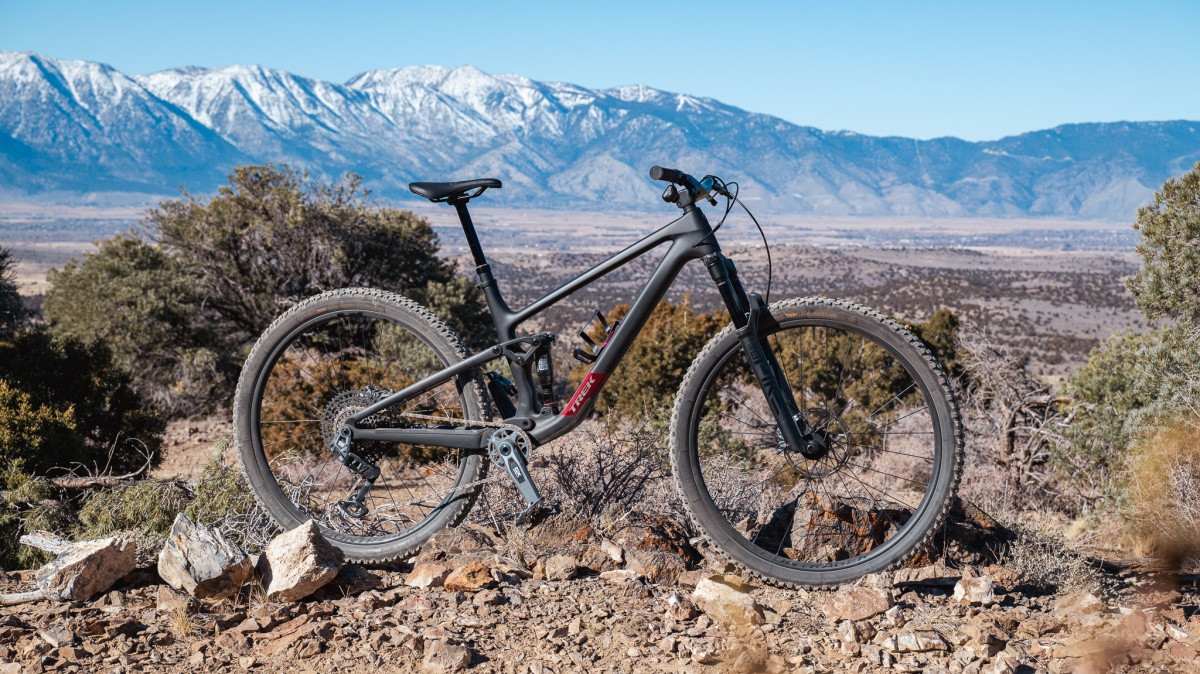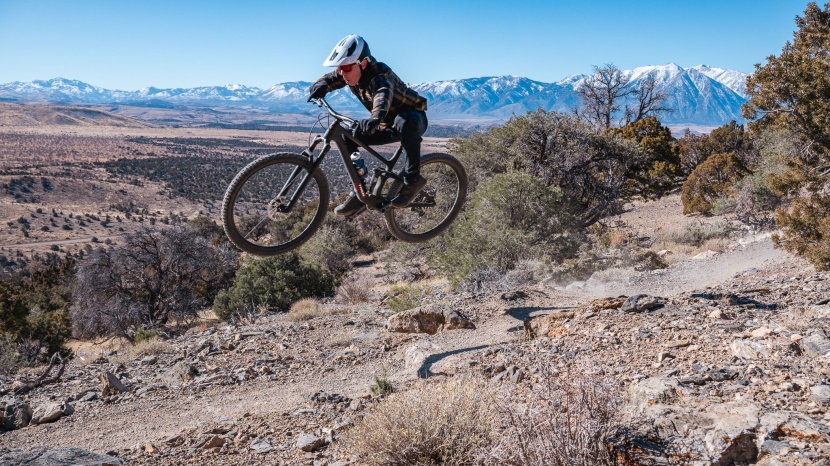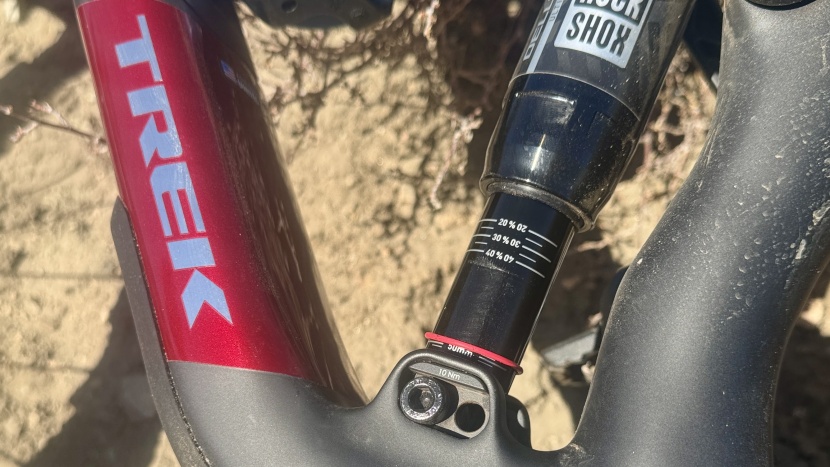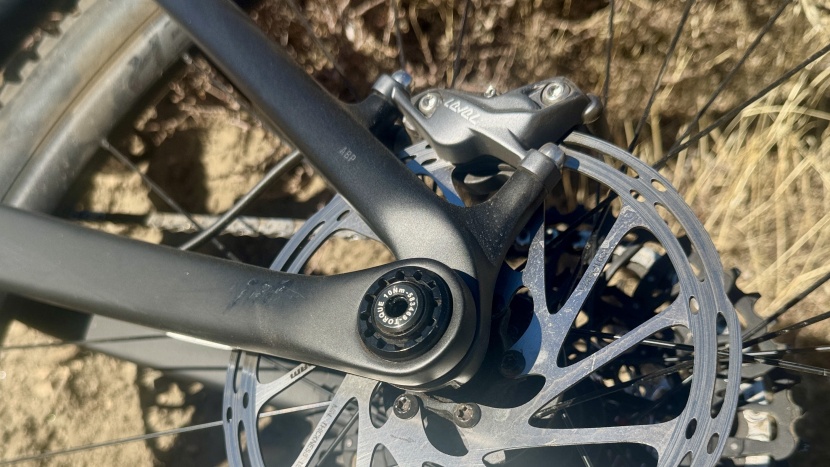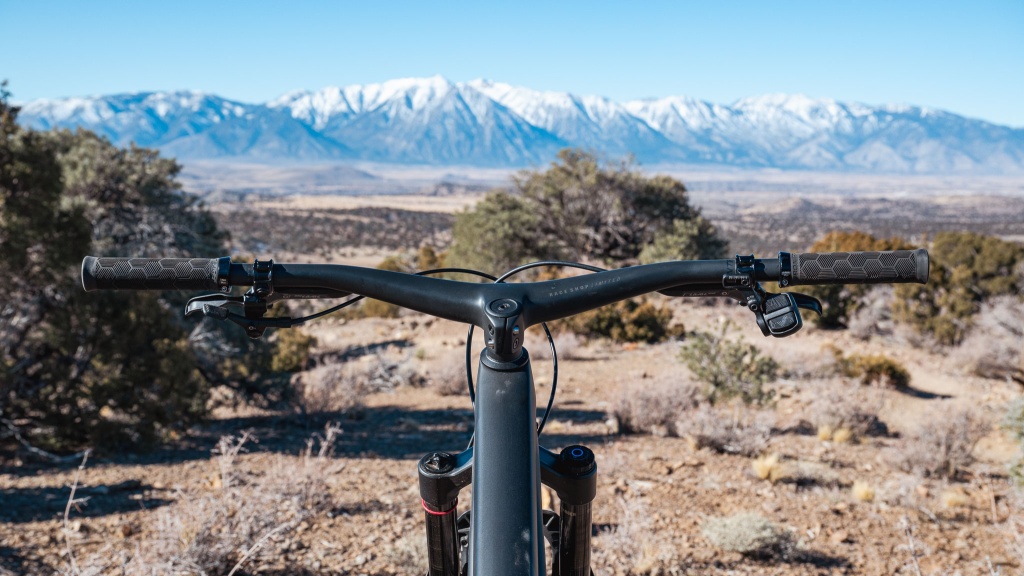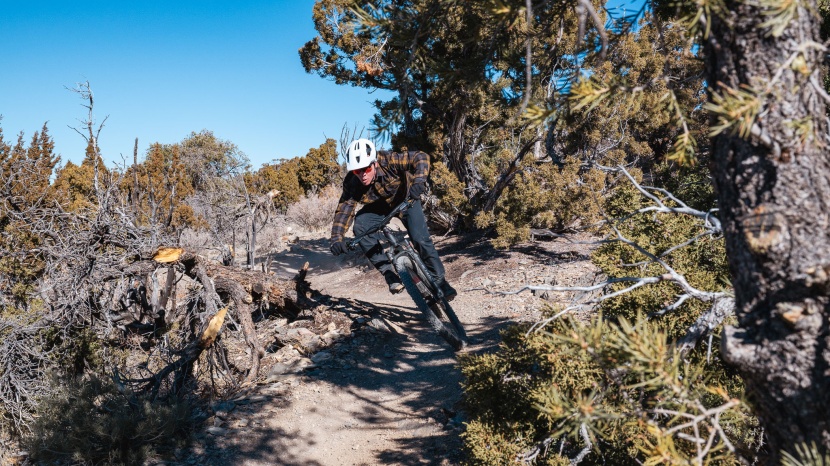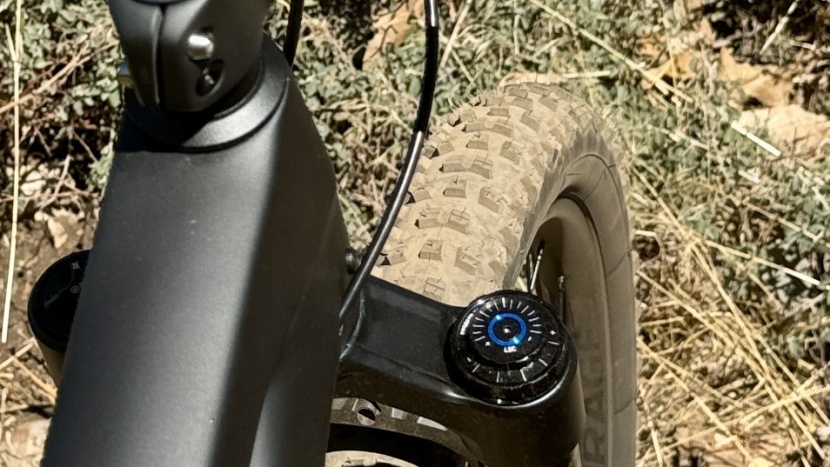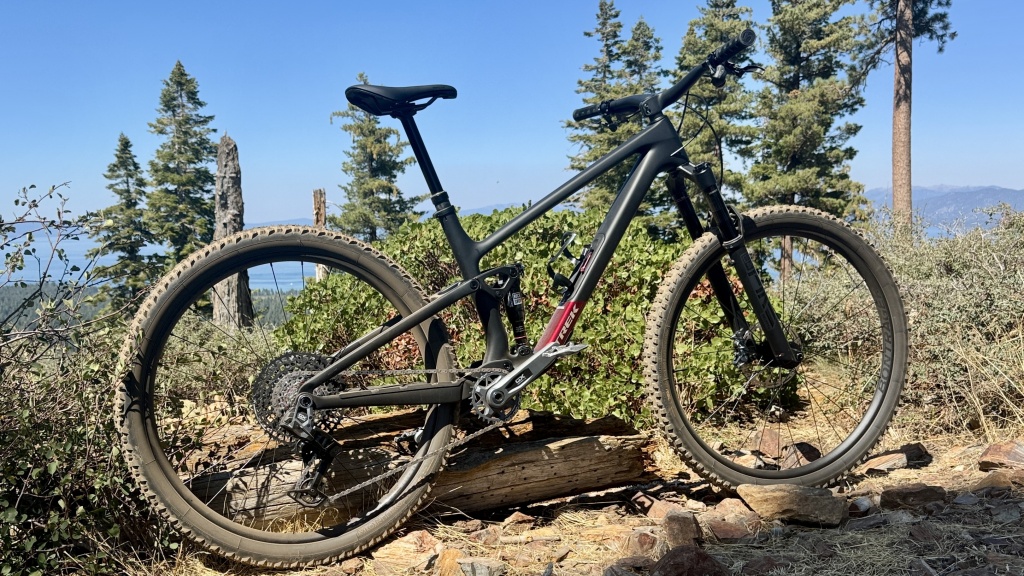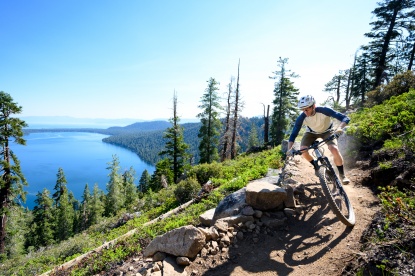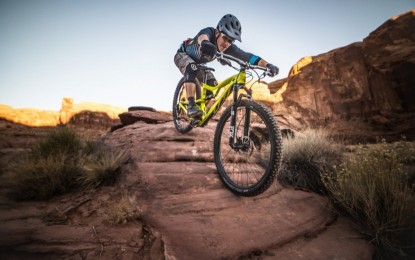Trek Top Fuel 9.8 GX AXS Review
Our Verdict
Compare to Similar Products
 This Product
Trek Top Fuel 9.8 GX AXS | |||||
|---|---|---|---|---|---|
| Awards | Best Short Travel Trail Bike | Best Aggressive Trail Bike | Best Overall Trail Bike | ||
| Price | $6,999 List | $7,299 List | $5,999 List | $5,500 List | $2,999 List |
Overall Score  |
|||||
| Star Rating | |||||
| Bottom Line | Like the descendant of an XC race bike and an all-mountain trail smasher, Top Fuel brings the best of both platforms with a healthy dose of adjustability | The best gets even better, and the V2 Ripmo is the best all-around trail bike we've ever tested | Trek delivers everything we want in a modern trail bike with a highly adjustable frame and a confidence-inspiring ride | Two models turned into one is a win for manufacturing efficiency; it's an excellent bike, but so are the two it replaces | The aluminum framed Ibis Ripmo AF is the best aggressive trail bike you'll find at this price |
| Rating Categories | Trek Top Fuel 9.8 G... | Ibis Ripmo V2 XT | Trek Fuel EX 9.8 GX... | Specialized Stumpju... | Ibis Ripmo AF NX Eagle |
| Fun Factor (25%) | |||||
| Downhill Performance (35%) | |||||
| Climbing Performance (35%) | |||||
| Ease of Maintenance (5%) | |||||
| Specifications | Trek Top Fuel 9.8 G... | Ibis Ripmo V2 XT | Trek Fuel EX 9.8 GX... | Specialized Stumpju... | Ibis Ripmo AF NX Eagle |
| Wheel size | 29" or MX | 29" | 29" | 29" or MX | 29" |
| Suspension & Travel | Active Braking Pivot (ABP) - 130mm | DW-Link - 147mm | ABP - 140mm | FSR - 145mm | DW-Link - 147mm |
| Measured Weight (w/o pedals) | 29 lbs 9 oz (Large) | 31 lbs (Large) | 32 lbs 9 oz (Large) | 32 lbs 9 oz (S4) | 34 lbs (Large) |
| Fork | RockShox Pike Select+ 130mm | Fox Float 36 Grip 2 Factory 160mm | Fox 36 Performance 150mm | Fox 36 Float Rythym 150mm | DVO Diamond D1 160mm |
| Shock | RockShox Deluxe Ultimate | Fox Float X2 | Fox Performace Float X | FOX FLOAT Performance with Specialized GENIE | DVO Topaz T3 Air |
| Frame Material | OCLV Mountain Carbon | Carbon Fiber | Carbon Fiber OCLV | Carbon Fiber | Aluminum |
| Frame Size | Large | Large | Large | S4 (Large equivalent) | Large |
| Frame Settings | 4-way Mino Link | N/A | Mino Link, Adjustable leverage | Headtube Nagle | N/A |
| Available Sizes | S-ML-XL | S-XL | XS-XL | S1-S6 | S-XL |
| Wheelset | Bontrager Line Comp 30, 30mm ID w/ Bontrager Hubs | Ibis S35 Aluminum rims with Ibis hubs, 35mm ID | Bontrager Line Elite 30, 30mm ID | Specialized 30mm, Alloy hubs | Ibis S35 Aluminum rims with Ibis hubs, 35mm ID |
| Front Tire | Bontrager Gunnison RSL XT 3C 29x2.4" | Maxxis Assegai EXO+ 2.5" | Bontrager SE5 Team Issue 2.5" | Specialized Butcher GRID TRAIL T9, 2.3" | Maxxis Assegai EXO+ 2.5" |
| Rear Tire | Bontrager Gunnison RSL XT 3C 29x2.4" | Maxxis Assegai EXO+ 2.5" | Bontrager SE5 Team Issue 2.5" | Specialized Eliminator GRID TRAIL T7, 2.3" | Maxxis Assegai EXO+ 2.5" |
| Shifters | SRAM AXS Pod | Shimano XT 12-speed | SRAM GX Eagle AXS | SRAM AXS Pod | SRAM NX Eagle |
| Rear Derailleur | SRAM GX Eagle AXS, T-Type | Shimano XT M8100 Shadow | Sram GX Eagle AXS | SRAM S1000 | SRAM NX Eagle |
| Crankset | SRAM GX Eagle T-Type DUB 170mm 30t | Shimano XT M8100 170mm 32T | SRAM GX Eagle DUB 170mm 32T | SRAM S1000 170mm 32T | SRAM NX Eagle DUB 32T |
| Saddle | Bontrager Verse Short Comp 145mm | WTB Silverado Pro 142mm | Bontrager Arvada 138mm | Specialized Bridge Comp | WTB Silverado Pro |
| Seatpost | Bontrager Line Dropper 170mm | Bike Yoke Revive (185mm size large) | Bontrager Line Elite 170mm | X-Fusion Manic 190mm (S4/S6), 34.9 diameter | KS Rage-i 150mm(Large) |
| Handlebar | Bontrager OCLV RSL Integrated 820mm | Ibis Adjustable Carbon 800mm (30mm rise) | Bontrager Carbon RSL Integrated 820mm | Specialized 6061 alloy, 30mm rise, 800mm width | Ibis 780mm Alloy |
| Stem | Integrated 45mm | Thomson Elite X4 | Bontrager RSL Integrated 45mm | Specialized Alloy Trail stem, 35mm bore | Ibis 31.8 50mm |
| Brakes | SRAM Level Bronze | Shimano XT M8120 4-piston | SRAM Code R | SRAM Maven Bronze | SRAM Guide T 4 piston |
| Measured Effective Top Tube (mm) | 630 | 632 | 627 | 624 | 631 |
| Measured Reach (mm) | 482 | 475 | 485 | 475 | 473 |
| Measured Head Tube Angle | 65.9-degrees H / 65.5-degrees L | 64.9-degrees | 63.5-65.5 (adjustable) | 63.5-65-degree (adjustable) | 64.9-degrees |
| Measured Seat Tube Angle | 76.3-degrees H / 75.9-degrees L | 76-degrees | 77.3-degrees H/76.8-degrees L | 76.5-degrees | 76-degrees |
| Measured Bottom Bracket Height (mm) | 349 H / 342 L | 341 | 342 H/338 L | 337 H / 330 L | 340 |
| Measured Wheelbase (mm) | 1227 | 1238 | 1250 | 1244 | 1239 |
| Measured Chain Stay Length (mm) | 439/440 | 435 | 440 (varies by size) | 435 (S3-S4) | 435 |
| Warranty | Lifetime | Seven Years | Lifetime | Lifetime | Seven Years |
Our Analysis and Test Results
Should I Buy This Bike?
Is it a long-travel XC bike, is it a short-travel trail bike, is it a down-countrybike, or is that even a real word? Does it even matter what category we try to stuff this bike in? The Top Fuel comes from Trek's racing heritage and has seen its fair share of podiums, but this new bike doesn't want to be boxed into the spandex side of the market. I spent months riding this bike and asking myself questions about where it fits into the mountain bike genus categorization, only to conclude that it doesn't matter. The new Top Fuel responds to your fierce input like an XC bike; the torsionally stiff and responsive frame makes the most of your pedal strokes, and you find yourself moving faster than expected. Then, at those fast speeds, you find yourself chasing down bigger lines and doing “not so XC” things. If you feel like trail bikes have tried to put too many blades in their swiss-army case, the Top Fuel is a delightful departure from that type of thinking. We don't all live in Moab, after all, and I too often find myself with more bike than I need or trying to dig harder lines to justify my choice of bike.
The Gen 4 Top Fuel gives up 120mm of travel from the venerable ABP suspension design but can also be run at 130mm with a longer stroke shock. The front end is designed around a 130mm fork, but it too can be bumped up to 140mm for a bit more aggressive riding. The 4-way Mino-Link allows you to tune the geometry and progression rate for multiple personalities from this OCLV Mountain carbon frame. The headtube angle can be changed from a razor-sharp 65.9 to a more trail-friendly 65.5 degrees, with the seat tube following at 76.3 and 75.9, respectively. Additionally, you can run a smaller rear wheel for the MX setup.
This bike is something of a chameleon with acceleration that rivals a gravel bike but confidence that doesn't shy away from those steep, loose, technical descents. Top Fuel's specs are impressive and check many of the boxes that matter. The build we chose is the 9.8 AXS, which packs a punch with SRAM GX Eagle AXS transmission shifting and Level Bronze 4-Piston brakes. RockShox handles suspension with their Pike Select+ 130mm fork using the DebonAir spring and Charger 3.1 RC2 damper. The rear end provides 120mm using a RockShox Deluxe Ultimate RCT shock. Both offer ample adjustability and complement the bike well. Bontrager Line Comp 30 wheels are solid wheels that work; the Rapid Drive 108 hub offers 3.3-degree engagement, and the 29mm (internal) rims set up tubeless with ease. The wheels use 28 standard J-bend spokes and weigh in at 1955 grams; that feels a bit heavy for this price range, but otherwise, I have no complaints. The feature that seems to attract the most attention is the Bontrager RSL Integrated bar stem. This is a polarizing choice as it doesn't allow you to independently adjust the sweep and rise in your bar or easily swap stem lengths. Our bar had an effective stem length of 45mm and a width of 820mm. You read that right; on our first ride, it felt like we were going to take flight. We trimmed the bar down to 780 and wouldn't have adjusted the sweep/rise if it were an option, so I generally loved the bar and the steering accuracy it provided.
Frame Design
The Top Fuel doesn't look radically different from its predecessor or other Trek mountain bikes, for that matter. Using OCLV Mountain Carbon, the 5.52-pound (Size M) frame relies on Trek's ABP suspension design, essentially a 4-bar with the rear pivot centered around the rear axle. The main pivot sits low on the seat tube, and the shock is mounted latitudinally in front of the seat tube. If you're new to this design, you should know that it rides like a typical Horst/4-bar but isolates braking forces away from the suspension action. This allows the suspension to remain active and plush while braking; it works well. All frames, even the Alpha Platinum Aluminum, have the same frame storage system with a Bontrager BITS bag that keeps your gear from rattling inside your down tube. The headtube is tapered, cables are internal, and all of the frame guards you could hope for have been provided. The rocker link is alloy, and the 4-way Mino-Link sits at the bottom of the shock mount.
A threaded shell and ISCG mounts grace the bottom bracket. The rear brake mount is native 180mm and compatible with a 200mm rotor if you need more stopping power. It probably goes without saying, but since this is a mountain bike review, the rear end is spaced at 148mm and is UDH-compatible. Size-specific chainstays range from 434mm to 445 on the five frame sizes (S-M-ML-L-XL).
The geometry of the Gen 4 continues its creep toward a more trail-capable platform but somehow hasn't lost the pep and agility the Top Fuel is known for. Is it longer and slacker? Well, yes, but just barely; the headtube relaxes by half a degree, and the reach grows by 2mm; we can't chalk up all of Trek's innovation to the standard longer/slacker treatment. The new bike has a slightly higher bb, largely due to a longer fork. Notably, the Gen 4 no longer uses a knock block, and the top tube is devoid of the upward curve that graced Gen 3 frames. The effective top tube has stayed the same (630/631mm) while size-specific chainstays grow the wheelbase of our size Large test bike by about 13mm. The new carbon frame is about a half-pound lighter than the Gen 3 carbon frame.
Design Highlights
- Available in OCLV mountain carbon and Apha Aluminum frames
- 29-inch wheels (27.5 on Small)
- MX compatible
- Size-specific chainstays
- Adjustable geometry and progression with 4-Way Mino-Link
- Downtube frame storage with BITS bag
- Threaded bottom bracket with ISCG
- Available in 5 sizes, including ML
- Downtube protection and chainstay armor
- Ability to run 140/130 travel (with different suspension components)
Downhill Performance
I didn't think this section would be a highlight of the review, but the Top Fuel has some chops when pointed downhill. The frame feels more torsionally rigid than the past model, and you typically feel this when sprinting or throwing the bike into a hard corner. What stands out here is how well the bike handles those lines that seem just above its pay grade. With no discernible flex in the front end, all of the trail input ends up right where it should be in the suspension, and the RockShox equipment shines here. The bike feels playful and agile; it's poppy off the ground and never feels reluctant to change directions.
During my first few weeks on the bike, I put it into conditions that felt like a bit much, but they weren't too much for the bike so much as the conditions and speed overwhelmed the Bontrager Montrose / Gunnison tire combo. After getting a good feeling for the capabilities of the wheels and tires, I put on a RaceFace ERA wheelset with Maxxis Minion tread and found a new level of capability from the bike. With adequate traction, I could rail sections of trail harder than I typically do on a 150/160 bike. There is no languishing in the travel, and hard braking doesn't induce chaos the way it can on some platforms. Swapping the wheels helped me understand the bike's capabilities more, and I suddenly found myself unhappy with Trek's choice of wheels; I finally had something to gripe about. I might not advocate that everyone swap to lighter wheels, but unless you live amongst bucolic, buff single track, I'd advise some meatier tread. The Montrose and Gunnison weigh around 1000 grams each, so you can pick up quite a bit of performance without adding much weight.
The cockpit is dominated by the sleek and responsive RSL bar; it looks especially clean with SRAM's stealth brake levers and lack of shift cable. The bar stem combo weighs just 250 grams and is incredibly stiff, giving the front end a precision feel; this was especially apparent picking through rocky pinball sections. A Bontrager Line Dropper post provides 170mm of drop on all models except the Small, which gets a 100mm post. Atop the dropper is a Trek Verse Short Comp saddle; as its name implies, it's short, real short. The 250mm saddle felt great on the descents, and I had no problem getting behind it when needed, but I never really loved it.
Uphill Performance
The Top Fuel taunts you on the way up. “Is this all the power you have? We can go faster. What's holding you back?” The responsive platform and stiff carbon frame gave me a gravel bike vibe with tremendously efficient power transfer. Very few, if any, full-suspension bikes get the power to the trail as effectively as the Top Fuel. Your hardest input is met with the bike's exceptional anti-squat, pushing you forward and upward. Climbing is incredibly gratifying, especially when riding with friends pushing larger trail bikes. Ninja and Samurai came to mind on most ascents, with the bike's athleticism on full display. The pedaling platform is so crisp and responsive it's almost surprising when you notice that the suspension is actively clawing away at the trail on your behalf. 3.3-degree engagement from the rear hub helps the bike feel almost enthusiastic about tackling technical problems. The stock wheels don't spin up as effortlessly as a lighter set of carbon wheels but don't really distract from the bike's performance. An effective seat tube angle of 75.9 to 76.3 gives you near-perfect leverage on all but the steepest grades.
In aggressive climbing situations, one can generally “ride the rivet,” an expression born out of old-school road cycling where you accelerate the seat tube angle by sitting on the tip of the saddle. It's become less relevant with steeper seat tubes, but it's still handy when the incline becomes extreme. The Verse saddle doesn't allow you to move forward as much as a standard-length saddle might, which can limit the amount of seated power you can produce. The RockShox Deluxe Ultimate RCT has a compression adjustment lever that allows for a locked-out feel, but I rarely used it, instead opting for the enhanced traction it provided with the low knob Montrose tire. I mentioned earlier that the frame feels torsionally stiff; this is the lack of flex you feel when loading it with opposing forces of upper and lower body power. The RSL handlebar also feels incredibly stiff and contributes to the bike's responsiveness when dancing out of the saddle.
Photo Tour
Value
The 9.8 GX AXS build we tested retails for $6999 with RockShox suspension and alloy wheels. That's the same price as the Fuel EX I tested last year with the same drivetrain and carbon wheels. This bike would arguably benefit from carbon wheels, but tacking that upgrade to the already high price tag feels inefficient. I loved scores of things about this bike, but I'm not sure the frame justifies a $3900 price tag. Curiously, Trek sells the same bike with a Shimano XTR build and carbon wheels for the same price. Admittedly, the current XTR is long in the tooth, but the bike weighs almost a pound and a half less, which would be welcomed. The AXS shifting is phenomenal, and once you become acquainted with it, returning to a cable-actuated system feels like talking on a phone with a cord. That said, the XTR build offers a significantly better value than the build I tested here.
The high-end build of the Top Fuel sells for $10,500, and the lower-tier build has a $6250 price tag. Trek also offers this bike with their Alpha Aluminum frame, starting at $2700 and peaking at $4800. It has a build similar to this but uses Fox suspension. The alloy frame offers the same adjustability and frame storage but costs about $1500 less and weighs 2.64 pounds more. The more you spend, the less you get.
Conclusion
The previous iterations of the Top Fuel didn't feel this versatile; instead, it felt like an arrow in your quiver. The new Top Fuel isn't exactly a quiver killer, but I found the bike far more capable than the outgoing model, and it exceeded my expectations in many ways. If you value efficiency over raw bravado and snappy handling over the calm confidence of today's slacker trail bikes, the Top Fuel is a real treat. I loved how responsive and agile the bike felt; as someone who isn't shy about being “under-biked,” the Trek provides more impressive performance than its geometry chart would indicate. The bike feels playful and incredibly well-engineered but offers less value than other models currently available. If you've been feeling like trail bikes have gotten too capable and want a simpler platform that still benefits from all the modern tech that makes trail bikes fun, hop aboard the new Top Fuel. Since Trek is widely distributed, finding a test ride from a dealer is easy, and they're so confident that you'll love this bike they back it with a 30-day money-back guarantee.


